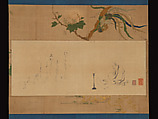Monk Kenkō Reading by Lamplight
Painting by Unidentified
Calligraphy by Imperial Prince-Monk Ryōshō 良尚入道親王 Japanese
Not on view
A fluid sketch painting, against a completely blank background, captures the appearance of a hunched-over elderly monk reading an unfurled scroll by a lampstand; behind him is a round, tiered, red-lacquer box. The inscription on the left in delicate script, mostly kana, is rendered in alternating long and short columns that gradually descend in height to create a triangular shaped composition that echoes the hunched-over posture of the figure. The identity of the subject as Monk Kenkō (1284–1350), the famous recluse-literatus of early medieval Japan, is revealed by the inscription, which transcribes the opening lines of Chapter 13 of Essays in Idleness (Tsurezuregusa), a literary miscellany created by the monk around 1330. The inscription reads:
ひとり、ともしひの本に 文をひろけて、みぬよの人をともとするこそ、こよなう藉ぐさむわさなれ。
Hitori, tomoshibi no moto ni fumi no moto ni o hirogete, minu yo no hito o tomo to suru koso, koyonō nagusamu waza nare
“The pleasantest of all diversions is to sit alone under the lamp, a book spread out before one, and to make friends with people of a distant past whom you have never known.”
(Trans. after Donald Keene)
In the passage that follows, not transcribed here, Monk Kenkō goes on to say that he particularly enjoys Chinese classics such as Wenxuan (Japanese: Monzen, a sixth-century Chinese anthology of prose and poetry), the Collected Poems of Tang-dynasty poet Bai Juyi, and the writings Daoist philosophers Laozi and Zhuangzi. He also says he is moved by the literature of Japanese writers of the past, and imagine that he indulging in a manuscript version of one those. The zeitgeist of Essays in Idleness is shaped by a fundamental asceticism and Buddhist-informed perception of the world and all mortal affairs as impermanent. Yet the presentation of his meditations on life are related with a droll wit that has made this medieval literary miscellany (zuihitsu) required reading for all students of Japanese literature. Tea aficionados find inspiration in Kenkō’s statements of a beauty that emanates from rustic, unaffected objects of daily use.
The highly refined calligraphy, bespeaking training in courtly styles of the past, is by the Imperial prince-monk Ryōshō, who for a decade served as head abbot of the Tendai sect. He was from a distinguished royal lineage: his great grandfather was Empero Ogimachi, and his paternal uncle was Emperor Go-Yōzei, one of the most talented imperial calligraphers of all. Ryōshō retired to Manshuin, a monseki temple (a cloister exclusively for monks of imperial stock), which was moved from its original location on Mount Hiei and reconstructed in 1656 in Kyoto, under the supervision of Ryōshō, and which is famous for it shoin-style rooms.
A later inscription on the box seems to suggest that only the inscription is by prince-monk Ryōsho, but since he was known to have studied painting as a young man with Kano Naonobu (1607–1650), it is reasonable to assume Ryōsho did both the painting and calligraphy. Furthermore, the placement of the ornate seal, which we decipher as an highly ornate seal script of the two characters of the name of the imperial prince-monk, Ryōshō 良尚, would suggest both pictorial and textual components were from the same hand.
The subdued, composition treating the subject of a monk who made vows of poverty is framed within a deluxe silk brocade mounting suitable for a work by an artist born into royalty. The phoenix and paulownia rendered in silk floss embroidery with interwoven gold-coated paper and couched gold threads on a gauzy open weave silk.
Due to rights restrictions, this image cannot be enlarged, viewed at full screen, or downloaded.
This artwork is meant to be viewed from right to left. Scroll left to view more.



